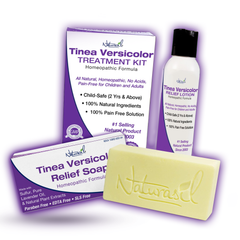¿Qué es la pitiriasis versicolor?
Tiña versicolor Es una infección micótica de la piel causada por Malassezia Cepa de levadura que vive naturalmente en su cuerpo. [1] Por lo general, este hongo vive inofensivamente en la piel; sin embargo, cuando ciertas condiciones provocan que crezca más rápido de lo habitual, presenta síntomas que podrían identificarse como tiña versicolor. Si bien la afección no es contagiosa, puede ser desagradable y afectar la autoestima debido a los cambios estéticos que causa el crecimiento excesivo del hongo.
Síntomas de la tiña versicolor
El síntoma más común de la tiña versicolor es una erupción cutánea hipopigmentada o hiperpigmentada que se presenta en parches. Esto significa que se presenta una erupción cutánea irregular con decoloración, ya sea más oscura o más clara que el color habitual de la piel; esta erupción no se broncea con el sol. Suele consistir en pequeñas manchas circulares u ovaladas de decoloración que, sin tratamiento, con el tiempo pueden agrandarse y unirse, formando parches mucho más grandes. [2] La erupción puede ser de color rosa, rojo, marrón o blanco y generalmente aparece en el pecho, el torso, la espalda o la parte superior de los brazos; a veces también puede afectar la cara o el cuello. [3]
Aunque los síntomas generalmente se limitan a la decoloración de la piel, en casos más raros, la erupción puede ser escamosa, elevada o causar picazón. [4] También es posible que observe alguna pérdida de cabello en las áreas de piel afectadas por la decoloración o descamación. [5] Este cabello volverá a crecer después de un tratamiento exitoso.
La afección suele ser inofensiva, pero este cambio estético en la piel puede causar angustia mental por inseguridad o pérdida de confianza, especialmente si se deja que empeore con el tiempo. La posible picazón o molestias también pueden afectar negativamente la calidad de vida, por lo que es importante tratar la tiña versicolor lo antes posible para evitar que empeore y, posteriormente, tomar las medidas adecuadas para prevenir su reaparición.
¿Qué causa la pitiriasis versicolor?
La tiña versicolor es causada por un crecimiento excesivo de la Malassezia Levadura que vive de forma natural en la piel. No es raro encontrar este hongo en la piel; de hecho, es una de las muchas cepas de hongos que suelen vivir inofensivamente en el cuerpo. Sin embargo, ciertas condiciones aumentan la probabilidad de que este hongo crezca excesivamente, causando finalmente los síntomas de la tiña versicolor.
Estos factores incluyen tener la piel sudorosa o grasosa, diabetes, uso de esteroides y afecciones que causan un debilitamiento de la piel. sistema inmunitario; cambios hormonales, incluido el uso de anticonceptivos orales; usar ropa ajustada o mascarillas; y vivir en un clima cálido y húmedo. [6] De hecho, los estudios muestran que en climas tropicales, hasta el 50% de las personas pueden sufrir de tiña versicolor, mientras que en países más fríos y secos, esta cifra podría ser tan baja como el 0,5% de las personas. [7]
La afección es más común en adolescentes y adultos de hasta 45 años debido a la piel ligeramente más grasosa o sudorosa presente en esta etapa de la vida. [8] En casos más raros, la tiña versicolor también puede afectar a niños y personas mayores; los menores de 14 años representan el 5% de los casos de la afección. [9]También es ligeramente más común en hombres que en mujeres, debido a las hormonas y la química de la piel de los hombres; las personas de todas las razas tienen la misma probabilidad de tener un caso de pitiriasis versicolor, aunque la decoloración puede ser más visible en ciertos colores de piel. [10]
La tiña versicolor no es contagiosa, ya que la causan hongos naturales. Si bien estudios han demostrado que vivir en contacto cercano con una persona con tiña versicolor no es un factor de riesgo para desarrollarla, se cree que la afección puede ser hereditaria. [11] Esto significa que si un padre o un hermano tiene un caso de pitiriasis versicolor, usted puede ser más propenso a desarrollar también un caso de esta enfermedad.
Cómo tratar la tiña versicolor
A menudo, las personas con tiña versicolor pueden sentirse un poco ansiosas por la posibilidad de curación y de que la piel recupere su tono habitual. Pero hay buenas noticias: la tiña versicolor es completamente curable y, tras el tratamiento, la decoloración de la piel se atenuará hasta desaparecer por completo.
Para tratar la tiña versicolor, es importante eliminar el crecimiento excesivo de hongos. Diversos estudios han demostrado que el tratamiento antimicótico es vital para curar la tiña versicolor. [12] Si bien existe una amplia gama de tratamientos para la tiña versicolor, a diferencia de muchos tratamientos de venta libre, las eficaces fórmulas de Naturasil utilizan únicamente ingredientes homeopáticos naturales. Esto ayuda a nuestros clientes a evitar productos químicos agresivos, efectos secundarios incómodos y el empeoramiento de la afección. Nuestros tratamientos son aptos para uso regular y solo utilizamos ingredientes naturales, de reconocida eficacia y totalmente seguros para la piel.
Aprovechar las propiedades antifúngicas naturales del azufre, el primer paso en nuestra Tineun paquete de control total Versicolor es el Púaun SuJabón lfurEl azufre limpiará y desinfectará la zona afectada, eliminando impurezas, bacterias y hongos de la piel. Esto ataca el crecimiento excesivo de hongos desde su origen y elimina el exceso. sebo en tu piel, que es uno de los factores que hacen que tu piel sea grasosa y, por lo tanto, más propensa a desarrollar tiña versicolor en primer lugar.
A continuación, después de secar bien la piel, aplicar nuestro Alivio de la tiña LociónCon una receta de ingredientes totalmente naturales, que incluye los mejores sanadores de la naturaleza, árbol de té, jojoba y lavanda, esta loción de alivio nutrirá y rehidratará tu piel. De rápida absorción, alivia el enrojecimiento y la picazón, ayudando a calmar y suavizar la piel mientras combate la infección por hongos. Finalmente, nuestra Púaun aceite tópico Debe aplicarse uniformemente sobre la zona afectada dos o tres veces al día con el práctico cepillo aplicador. Las potentes propiedades antifúngicas de este aceite alivian la picazón y las molestias mientras actúa sobre la infección fúngica, ayudando a reducir la inflamación y a devolverle a la piel su belleza natural.
Si bien puede tomar algunas semanas, o en los casos más graves, hasta algunos meses, para que los síntomas de la tiña versicolor desaparezcan por completo, algunos de nuestros clientes informan que ven cambios visibles dentro de las 48 horas de usar nuestros productos.Una vez que la decoloración haya desaparecido por completo, puedes estar seguro de que tus niveles naturales de levadura estarán nuevamente bajo control. [13]
¿Volverá mi tiña versicolor?
Es posible que sus síntomas de tiña versicolor reaparezcan, sobre todo si aún está expuesto a los factores de riesgo que influyeron en su caso actual. Por ejemplo, si vive en un clima tropical, podría notar que sus síntomas reaparecen en temporadas particularmente húmedas. Un estudio reveló que alrededor de dos tercios de las personas que han tenido un caso de tiña versicolor la volverán a padecer en algún momento de su vida. [14]Por lo tanto, la prevención adecuada es clave para mantener la tez uniforme y la piel suave y libre de hongos.
Existen muchas medidas preventivas que puedes tomar para mantener tus niveles de hongos bajo control. Cómo evitar la sudoración excesiva: Un método es usar ropa holgada hecha de fibras naturales como el algodón o telas sintéticas que absorban el sudor y que absorben el exceso de humedad de la piel. Si alguna loción te está engrasando la piel, considera cambiar a un producto alternativo. Finalmente, asegúrate de secarte bien después de lavarte para evitar que el exceso de humedad se quede en tu cuerpo al vestirte.
Aunque el hongo que causa la tiña versicolor vive de forma natural en la piel, es totalmente posible prevenir su crecimiento excesivo y, por lo tanto, futuros casos de tiña versicolor. Para regular los niveles de levadura en el cuerpo y prevenir su reaparición, recomendamos tomar dos Naturasil Candida Support Tabletas diarias. Estas tabletas actúan equilibrando los niveles de levadura en el cuerpo y promoviendo un intestino sano, lo que limita la posibilidad de que los hongos naturales crezcan descontroladamente en el futuro.
Nuestro Tiña VeKit de tratamiento preventivo rsicolor Incluye todo lo necesario para mantener la piel limpia, suave y libre de hongos. Con el uso regular, nuestros productos son eficaces para prevenir la recurrencia de la tiña versicolor y mantener la piel libre de otras impurezas. Los compuestos de azufre en el... ADVABarra limpiadora de azufre para la tiña nced Continuará controlando los hongos en la piel y, al mismo tiempo, le ayudará a mantener una tez limpia al eliminar bacterias y toxinas. A continuación, el uso de... Intensive Tineuna loción de alivio Mantendrá tu piel uniforme e hidratada durante todas las estaciones al tiempo que previene la reaparición de enrojecimiento o descamación de la piel.
Aunque no es raro que la tiña versicolor reaparezca, con las medidas preventivas adecuadas, la afección se puede curar y prevenir futuros casos. Como nuestros productos son seguros para su uso regular y continuo, puede mantener su piel libre de hongos independientemente de su estilo de vida o factores de riesgo, con la tranquilidad de que su cuerpo también se mantendrá nutrido y rejuvenecido.
[1] Leung, A.K.C., Barankin, B., Lam, J.M., Leong, K.F., y el Honorable, K.L. (2022). 'Tiña versicolor: una revisión actualizada'. Las drogas en contexto, 11.
[2] Méndez-Tovar, L.J. (2010). 'Patogénesis de la dermatofitosis y la tiña versicolor.' Clínicas de Dermatología, 28(2), 185-189.
[3] Savin, 1996.
[4] Borelli, y otros, 1991.
[5] Leung, y otros, 2022.
[6] Leung, y otros, 2022.
[7] Ibídem.
[8] Borelli, D., Jacobs, P.H., y NaIl, L. (1991). 'Tiña versicolor: Epidemiología, clínica y
'aspectos terapéuticos'. Revista de la Academia Americana de Dermatología, 25(2), 300-305.
[9] Savin, R. (1996). 'Diagnóstico y tratamiento de la tiña versicolor'. Revista de Medicina Familiar, 43(2), 127-132.
[10] Leung, y otros, 2022.
[11] Borelli, y otros, 1991.
[12] Savin, 1996.
[13] Leung, y otros, 2022.
[14] Ibídem.






